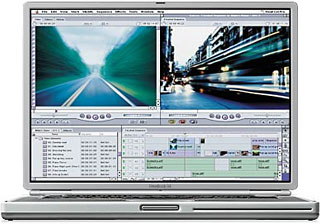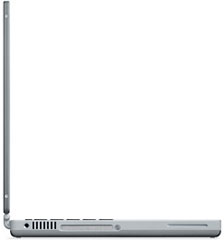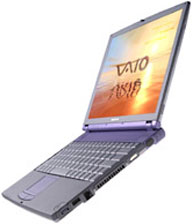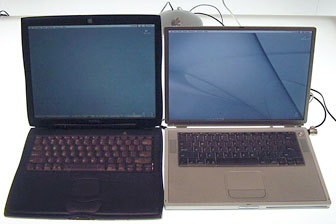These columns originally appeared on Mac Opinion (dated Jan. 16 and
23, 2001) and disappeared from the site after a hard drive crash. Low
End Mac is republishing them, since we have several links to these
columns on the site. dk
Wow! Last week, when I predicted that the PowerBook landscape was
about to be radically transformed, I figured that the new 'Book would
be pretty cool, but I never anticipated that Apple would fill so many
of the items on my wish list, exceeding some of them.

Apple's new Titanium PowerBook G4
The new Titanium G4
PowerBook (I predict that the development code name, Mercury, will
be eclipsed) is simply the coolest piece of hardware Apple has ever
built. A grand slam home run. It is such a watershed, that I intend on
devoting two consecutive Road Warrior columns to discussing it. This
week I will offer some general impressions, and next week we will get
down to the technical nitty gritty.
If the reception "Ti" is getting among my circle of friends and
colleagues is any indication, Apple will have its corporate hands full
keeping up with demand for this baby. My son, Tristan, is entertaining
offers for his Lombard and
plotting how to raise the cash to buy a 500 MHz Ti. Fellow Applelinks
news editor and iBook user John Farr wants one. Low End Mac's Dan
Knight, who has long professed that the main thing holding him back
from switching to a PowerBook as his main workhorse Mac was the
unavailability of a large enough display, now
says that a Ti will nicely fill the role currently served by his
trusty SuperMac S900 (with 333 MHz
G3 upgrade).
Personally, I am heartily thanking myself that I did not follow up
my inclination to buy one of the new Paris iBook 466 MHz models
introduced in September. While the iBooks are worthy machines, I am
still nonplused by the styling, the 12.1-inch screen is too much of a
compromise, and I would be kicking myself senseless had I blown the
system upgrade budget on one of these nice (but not quite up to my
requirements) units.
As it is, the introduction of the Titanium PowerBook meshes nicely
with my provisional system upgrade timetable. My target is to go three
years between system upgrades, and this WallStreet 233 MHz machine I
am writing on has just passed the two-year mark, having recently gained
a new lease on wife with the addition of a 10.2 gigabyte Toshiba hard
drive, an upgrade to 192 MB of RAM, a USB PC Card adapter, and a
FireWire PC card adapter.
I had also been negotiating a possible purchase of a 466 MHz
processor upgrade for the WallStreet with Roger Kasten of Newer
Technology prior to Newer's sudden meltdown, but I am now thankful that
that deal was not consummated, because while I am very satisfied with
having spent a modest amount on the additions I have made to the
WallStreet, which had begun to fall short of meeting my needs, the
processor upgrade would involve serious money that I would now much
rather put toward the purchase of a Ti.
The bigger hard drive and expanded RAM, plus Mac OS 9.1, have
speeded up the WallStreet to a degree that I am quite comfortable with
it again (along with the introduction of MacSpeech's iListen, which is
so much faster and more versatile than poky IBM ViaVoice) speed
wise.
If the universe unfolds as I suspect it will, my arbitrary
three-year mark will be approaching at the time the first generation
T-machines will very likely be discounted to clear the channels for the
next speed-bumped models, and a 400 MHz unit will suit me just fine. Of
course, discounts are not inevitable; Lombard weathered its entire
eight-month production run at a constant price point. However, in any
event, this plan gives me another ten months or so to save up.
Also, by the time I buy my Ti, if the good Lord is willing and the
creek don't rise, Apple will have had time to work around the
inevitable bugs and teething problems that can be expected with a model
this revolutionary. I am not an early adapter by temperament. A good
object lesson is that the
early WallStreets, which had their troublesome aspects and aren't
supported for OS X, while my WallStreet Rev. B supports OS X and
has never missed a beat in two years.

 But back
to the Ti itself. I am absolutely blown away by the styling of this
machine. There's no accounting for aesthetic taste, I guess. I think
that this new PowerBook is drop dead gorgeous, but then I have always
been partial to thin, flat, rectangular shapes. I loved the looks of
the Sony VAIO (right) from the first glimpse I got of it in a magazine
photograph three years ago, and I have always thought that the thinner,
flatter models of IBM's ThinkPad were extremely attractive and classy
looking.
But back
to the Ti itself. I am absolutely blown away by the styling of this
machine. There's no accounting for aesthetic taste, I guess. I think
that this new PowerBook is drop dead gorgeous, but then I have always
been partial to thin, flat, rectangular shapes. I loved the looks of
the Sony VAIO (right) from the first glimpse I got of it in a magazine
photograph three years ago, and I have always thought that the thinner,
flatter models of IBM's ThinkPad were extremely attractive and classy
looking.
I thought the proportions and clean styling of the original compact Macs (mine is a Mac Plus), were just about perfect,
and I find them no less attractive now than when they originally
debuted, but my all-time favorite Macintosh desktop CPU form factor is
the so-called "pizza box" unit introduced in 1993 as the Centris 610, and which had a second life
as the Power Mac and Performa
6100 series. On the other hand, the iMac has never done anything for me
aesthetically, although I appreciate it for its superb value. I like
the looks of the Cube,
but am more or less ambivalent about the styling of the blue and white G3 and the
Power Mac G4. And
Apple towers, as well as most modular Mac desktop boxes prior to that,
were simply mediocre looking.
On the other hand, I have never liked the styling of the PowerBook
G3 series very much. The WallStreet is the most successful of the three
versions, but the only aspect I find even moderately fetching is the
view from the rear, where the upswept bottom corners combined with a
cooling vent on the left hand side give a sort of Star Wars spaceship
impression. This was removed with the Lombard and Pismo, which seem to
me nondescript looking.
Conversely, looking at my PowerBook 5300, with its compact,
understated, squared off lines, always brought a smile to my face, and
still does after four years of looking at it. I also am quite partial
to the clean lines of the PowerBook
1400.
As for other Mac portables, the voluptuous, somewhat organic shape
of the iBook has never appealed to me. The PowerBook 500 series was
spectacular looking when it rolled out in 1994, especially after the
angular 100 series books, which I always thought were plug ugly, but
the 500's styling did not wear well with me, and I really don't find it
at all attractive anymore. The PowerBook 3400 is an object lesson in
how important proportions are to aesthetics. The 3400 is basically a
"stretch" PowerBook 5300 in terms of styling, but a bit too much of the
stretch in terms of attractiveness, although I still like it better
than the 500 or the two most recent iterations of the G3 series.
Of course, just because I don't like a computer's looks doesn't mean
I won't buy one. I was very seriously considering the purchase of a
Paris iBook last fall. The all-in-one 500
series desktops, like my LC
520, have never appealed to me visually, and I have always
considered them clumsy looking and visually unattractive. Seven years
of looking at mine has not caused me to alter that assessment.
I have been looking at my WallStreet PowerBook for two years now,
and the same applies. I don't think it is ugly, but its looks don't
make me smile (its power and dependability do though).
 In photos, its humongous display and wider footprint make
the Ti look bigger than it is. However, parked beside a Pismo in a
photo (adapted and reduced from one originally published on
MacNN on a page that
no longer exists - ed) you get a better sense of proportion.
Except for width, the Pismo dwarfs it, and it would look positively
petite beside my WallStreet. That's fine with me - the smaller the
better, within the bounds of acceptable performance, feature set,
comfortable ergonomics, and display size. Ti's dimensions are: 13.4"
x9.5" x1".
In photos, its humongous display and wider footprint make
the Ti look bigger than it is. However, parked beside a Pismo in a
photo (adapted and reduced from one originally published on
MacNN on a page that
no longer exists - ed) you get a better sense of proportion.
Except for width, the Pismo dwarfs it, and it would look positively
petite beside my WallStreet. That's fine with me - the smaller the
better, within the bounds of acceptable performance, feature set,
comfortable ergonomics, and display size. Ti's dimensions are: 13.4"
x9.5" x1".
Speaking of which, I'm kind of sorry that Apple didn't use the extra
width to incorporate closer to a full 105 key keyboard layout, for
which there would now appear to be room. Also, initial reports indicate
that while the Titanium case should be very robust, the keyboard is a
tad flimsy, which is not good news. I think that the WallStreet
keyboard strikes a pretty good balance between ruggedness and weight,
and perhaps Apple has tipped the scale just a shade too far toward the
latter with the Ti.
Apple is making no secret of the fact that the Sony VAIO was its
target to exceed. The VAIO is a very nice piece of work as PC boxes go,
but the Ti leaves it in its dust, with its solid titanium case vs. the
VAIO's magnesium-fortified plastic one, and the big, 15.2-inch display,
as opposed to VAIO's pedestrian 12.1-inch unit, and of course the G4
"supercomputer to go" power. All this for a measly 50 bucks more than
the VAIO.
Apple is convincingly king of the hill again in the laptop
orbit.
Speaking of the G4 processor, it's a Motorola "Nitro 1.3" specially
modified for mobile use. Personally, I don't consider the G4 a big
deal, and my preference would have been for a coooler-running, lower
power consumption, fast G3 chip such as IBM's 750cxe 733 MHz unit. Of
course, I don't use Photoshop or any other AltiVec-optimized software,
and my power demands are quite modest, as the fact that still I find a
233 MHz G3 quite adequate attests.
Reports from the Macworld Expo floor affirm that the Ti runs pretty
hot, and nominal battery life is not improved from that of Pismo and
Lombard - and Apple has incorporated a PC style fudge in the form of
PowerStep, which conserves power by reducing the PowerPC G4's clock
speed by 100 MHz when running on battery power if activated. It would
have been great if Apple had offered an entry-level Ti with a 733 MHz
G3 at, say, $2,195, and that one would have been my hands-down choice,
but I suppose it would have been considered too confusing to have the
entry-level model sporting a clock speed 233 MHz higher than the
high-end machine.
The Titanium case is one of this 'Book's killer features, both from
an engineering and aesthetic perspective. Apple is, to the best of my
knowledge, the first company to completely construct a laptop chassis
from 99.5% pure titanium. I have a thing for titanium. One of the minor
regrets in my life is that I never purchased a really cool set of
eyeglass frames made of the stuff that I found on sale cheap at an
optician's about a decade ago. They were soooooo light, cool-looking,
and claimed to be extraordinarily strong as well.
According to the International Titanium
Association, there are three structural types of titanium (Ti)
alloys, and titanium “is the most biocompatible of all
metals,” widely used for surgical implants, joint replacements,
and other medical devices.
Titanium’s superior tensile strength and low density give it
the greatest strength-to-weight ratio of any of today’s
structural materials, and 60% of global titanium production is used in
the aerospace industry. Apple's Ti also has a carbon fiber frame to
provide extra structural rigidity.
Attributes of titanium alloys import from an engineering perspective
include:
- Outstanding corrosion resistance
- Acid resistance
- Resistance to waters
- Resistance to gases
- Excellent erosion resistance
- High heat transfer efficiency
- Superior strength-to-weight ratios
- Low coefficient of expansion
- Nonmagnetic
- Excellent fire resistance
- Short radioactive half life
I was a bit disappointed to learn that the Ti's case is not bare
mental, but rather painted. Apparently Apple discovered that the
titanium tended to stain from hand contact, a prospect that does not
offend me, as the concept of the PowerBook acquiring a patina from use
is quite appealing. However, it was deemed to be something that would
not play well in Peoria, so painted it is. We can be thankful that at
least Mr. Jobs did not get his way and paint the Ti black, the hitch
being that a black metal machine would scratch bright.
I don't necessarily find black, monolithic slab style laptops
unattractive, as previously noted I like the looks of IBM's ThinkPads.
However, this is a metal machine - not just another plastic molding job
- and it deserves to look like metal.
I am just old enough to have absorbed the notion that plastic is an
inferior material to real engineering media like wood, metal, and
glass. When I was growing up in the 1950s, plastic stuff was still
consensually deemed to be second-class, a reflexive judgment I have
never been able to shake, despite subsequent reasoned conviction that
in some cases, plastic really is better for certain applications and
particular tasks. However, a metal PowerBook represents swimming
against the current of plasticization, and that tickles me.
Next week, we will take a look at
how well Ti measures up to my advocacy of PowerBooks as "the logical
Mac" - a substitute for a desktop Mac.
Some of the issues we will cover include:
- Details on the 15.2-inch display; does it offer adequate
resolution?
- How come you can't use Apple external monitors with Ti?
- Expandability?: No more expansion bay and only one FireWire
port.
- Is 128 MB enough standard RAM?
- Ti's rather pedestrian video support by today's standards
- Is a 10 gigabyte, 4200 RPM hard drive too stingy?
- No more quick change batteries
- Bus speed still 100 MHz
- Will the screen hinges be more robust compared with the G3
series?
- No analog audio input
- Why you won't need an Ethernet crossover cable with Ti
- Getting inside the Ti; what is user serviceable?
In the meantime here are the raw technical specs for the Titanium G4
PowerBook
Configurations
- 400 MHz G4 processor, 128 MB RAM, 20 GB disk, Rage 128 mobility
graphics, one FireWire port, two USB ports, VGA out, dual AirPort
antennae, $2599.
- G4 500 MHz G4 processor, 256 MB RAM, 30 GB disk, Rage 128 mobility
graphics, one FireWire port, two USB ports, VGA out, dual AirPort
antennae, $3499.
Technical Specifications
Processor and memory
- 400 or 500 MHz PowerPC G4 processor with Velocity Engine
- 1 MB backside level 2 cache on processor module; 200- or 250 MHz
dedicated 64-bit backside bus
- 100-MHz system bus
- Integrated floating-point unit and 64K on-chip level 1 cache (32K
data and 32K instruction)
- 128 MB or 256 MB of PC100 SDRAM; two SO-DIMM slots support up to
1 GB
Storage
- Internal 10 GB, 20 GB, or 30 GB Ultra ATA/66 hard disk drive (30 GB
drive available in build-to-order computers)
- Slot-loading DVD-ROM drive reads DVD-ROM, DVD-Video, DVD-RAM, and
CD-ROM discs
Communications
- Built-in 10/100BASE-T Ethernet (RJ-45 connector)
- Built-in 56K V.90 modem (RJ-11 connector)
- Optional 11-Mbps AirPort Card (IEEE 802.11 DSSS compliant)
- Infrared technology port (4-Mbps IrDA)
Expansion
- One 400-Mbps FireWire (IEEE 1394) port
- Two 12-Mbps USB ports
- One PC Card and CardBus slot
- Support for one Type I or Type II PC Card or CardBus card
- Support for a Zoom Video PC Card
Audio
- 16-bit CD-quality stereo output (minijack)
- Two built-in stereo speakers
- Internal omnidirectional microphone
Battery and power
- 50-watt-hour lithium-ion battery with integrated charge indicator
LEDs provides up to 5 hours of battery life
- Power adapter with cable management systemPower adapter port
Security
- Kensington cable lock slot
- Keyboard lock
Video and graphics support
- 8MB of SDRAM video memory supports millions of colors on external
VGA monitors up to 21 inches
- Built-in 2D/3D graphics acceleration through an integrated ATI RAGE
Mobility 128 video controller with AGP 2X24-bit video output port
(VGA-style connector)
- S-video output portS-video to composite adapter
Display
- 15.2-inch (diagonal) built-in TFT widescreen active-matrix display
- Supports millions of colors at 1152 x x768-pixel resolution
- Supports resolutions of 1152 x 768, 896 x 600, and 720 x 480 pixels
at 3:2 aspect ratio
- Supports resolutions of 1024 x 768, 800 x 600, and 640 x 480 pixels
at 4:3 aspect ratio
Keyboard
- Built-in full-size keyboard with 77 (U.S.) or 78 (ISO) keys,
including 12 function keys, 4 arrow keys (inverted "T" arrangement),
and embedded keypad
Apple trackpad
- Solid-state trackpad provides precise cursor control; supports tap,
double-tap, and drag capabilities
Size and weight
- Height: 1.0 inches (2.6 cm)
- Width: 13.4 inches (34.1 cm)
- Depth: 9.5 inches (24.1 cm)
- Weight: 5.3 pounds (2.4 kg) with battery installed



 But back
to the Ti itself. I am absolutely blown away by the styling of this
machine. There's no accounting for aesthetic taste, I guess. I think
that this new PowerBook is drop dead gorgeous, but then I have always
been partial to thin, flat, rectangular shapes. I loved the looks of
the Sony VAIO (right) from the first glimpse I got of it in a magazine
photograph three years ago, and I have always thought that the thinner,
flatter models of IBM's ThinkPad were extremely attractive and classy
looking.
But back
to the Ti itself. I am absolutely blown away by the styling of this
machine. There's no accounting for aesthetic taste, I guess. I think
that this new PowerBook is drop dead gorgeous, but then I have always
been partial to thin, flat, rectangular shapes. I loved the looks of
the Sony VAIO (right) from the first glimpse I got of it in a magazine
photograph three years ago, and I have always thought that the thinner,
flatter models of IBM's ThinkPad were extremely attractive and classy
looking. In photos, its humongous display and wider footprint make
the Ti look bigger than it is. However, parked beside a Pismo in a
photo (adapted and reduced from one originally published on
MacNN on a page that
In photos, its humongous display and wider footprint make
the Ti look bigger than it is. However, parked beside a Pismo in a
photo (adapted and reduced from one originally published on
MacNN on a page that 
